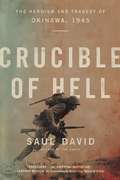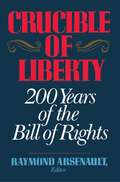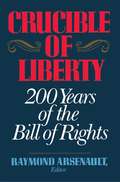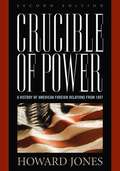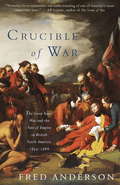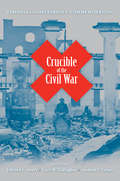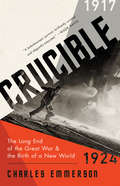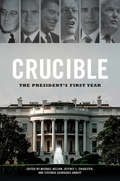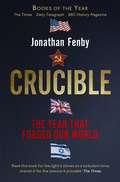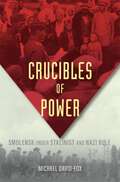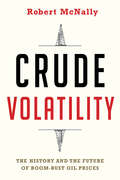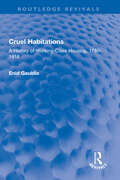- Table View
- List View
Crucible of Faith: The Ancient Revolution That Made Our Modern Religious World
by Philip JenkinsOne of America's foremost scholars of religion examines the tumultuous era that gave birth to the modern Judeo-Christian traditionIn The Crucible of Faith, Philip Jenkins argues that much of the Judeo-Christian tradition we know today was born between 250-50 BCE, during a turbulent "Crucible Era." It was during these years that Judaism grappled with Hellenizing forces and produced new religious ideas that reflected and responded to their changing world. By the time of the fall of the Temple in 70 CE, concepts that might once have seemed bizarre became normalized-and thus passed on to Christianity and later Islam. Drawing widely on contemporary sources from outside the canonical Old and New Testaments, Jenkins reveals an era of political violence and social upheaval that ultimately gave birth to entirely new ideas about religion, the afterlife, Creation and the Fall, and the nature of God and Satan.
Crucible of Fire: Nineteenth-Century Urban Fires and the Making of the Modern Fire Service
by Bruce HenslerUrban conflagrations, such as the Great Chicago Fire of 1871 and the Great Boston Fire the following year, terrorized the citizens of nineteenth century American cities. However, urban rebirth in the aftermath of great fires offered a chance to shape the future. Ultimately residents and planners created sweeping changes in the methods of constructing buildings, planning city streets, engineering water distribution systems, underwriting fire insurance, and fire fighting itself. Crucible of Fire describes how the practical knowledge gained from fighting nineteenth-century fires gave form and function to modern fire protection efforts. Changes in materials and building design resulted directly from tragedies, such as fires in supposedly fireproof hotels. Thousands of buildings burned, millions of dollars were lost, the fire insurance industry faltered, and the nature of volunteerism changed radically before municipal authorities took the necessary actions. The great fires formed a crucible of learning for firefighters, engineers, architects, underwriters, and citizens. Veteran firefighter Bruce Hensler shows how the modern American fire service today is a direct result of the lessons of history and examines the efficacy of volunteerism in fighting fires. Crucible of Fire is an eye-opening look at today’s fire service and a thorough examination of what firefighters, civic leaders, and ordinary citizens can do to protect their homes and communities from the mistakes of the past. BRUCE HENSLER has thirty-four years of firefighting experience and degrees in fire science and public administration. His range of experience includes urban and suburban fire departments, as well as senior positions as a chief fire officer and deputy director of fire service training. A fire service and public policy analyst, he is also a paid-call fire officer for Rockport, Maine.
Crucible of Gold: A Novel of Temeraire (Temeraire #7)
by Naomi NovikNaomi Novik's beloved series returns, with Captain Will Laurence and his fighting dragon Temeraire once again taking to the air against the broadsides of Napoleon's forces and the friendly--and sometimes not-so-friendly--fire of British soldiers and politicians who continue to suspect them of divided loyalties, if not outright treason. For Laurence and Temeraire, put out to pasture in Australia, it seems their part in the war has come to an end just when they are needed most. But perhaps they are no longer alone in this opinion. Newly allied with the powerful African empire of the Tswana, the French have occupied Spain and brought revolution and bloodshed to Brazil, threatening Britain's last desperate hope to defeat Napoleon. And now the government that sidelined them has decided they have the best chance at negotiating a peace with the angry Tswana, who have besieged the Portuguese royal family in Rio--and thus offer to reinstate Laurence to his former rank and seniority as a captain in the Aerial Corps. Temeraire is delighted by this sudden reversal of fortune, but Laurence is by no means sanguine, knowing from experience that personal honor and duty to one's country do not always run on parallel tracks. Nonetheless, the pair embark for Brazil, only to meet with a string of unmitigated disasters that force them to make an unexpected landing in the hostile territory of the Incan empire, where they face new unanticipated dangers. Now with the success of the mission balanced on a razor's edge, and failure looking more likely by the minute, the unexpected arrival of an old enemy will tip the scales toward ruin. Yet even in the midst of disaster, opportunity may lurk--for one bold enough to grasp it.From the Hardcover edition.
Crucible of Hell: The Heroism and Tragedy of Okinawa, 1945
by Saul DavidFrom the award-winning historian, Saul David, the riveting narrative of the heroic US troops, bonded by the brotherhood and sacrifice of war, who overcame enormous casualties to pull off the toughest invasion of WWII's Pacific Theater -- and the Japanese forces who fought with tragic desperation to stop them.With Allied forces sweeping across Europe and into Germany in the spring of 1945, one enormous challenge threatened to derail America's audacious drive to win the world back from the Nazis: Japan, the empire that had extended its reach southward across the Pacific and was renowned for the fanaticism and brutality of its fighters, who refused to surrender, even when faced with insurmountable odds. Taking down Japan would require an unrelenting attack to break its national spirit, and launching such an attack on the island empire meant building an operations base just off its shores on the island of Okinawa.The amphibious operation to capture Okinawa was the largest of the Pacific War and the greatest air-land-sea battle in history, mobilizing 183,000 troops from Seattle, Leyte in the Philippines, and ports around the world. The campaign lasted for 83 blood-soaked days, as the fighting plumbed depths of savagery. One veteran, struggling to make sense of what he had witnessed, referred to the fighting as the "crucible of Hell." Okinawan civilians died in the tens of thousands: some were mistaken for soldiers by American troops; but as the US Marines spearheading the invasion drove further onto the island and Japanese defeat seemed inevitable, many more civilians took their own lives, some even murdering their own families. In just under three months, the world had changed irrevocably: President Franklin D. Roosevelt died; the war in Europe ended; America's appetite for an invasion of Japan had waned, spurring President Truman to use other means -- ultimately atomic bombs -- to end the war; and more than 250,000 servicemen and civilians on or near the island of Okinawa had lost their lives. Drawing on archival research in the US, Japan, and the UK, and the original accounts of those who survived, Crucible of Hell tells the vivid, heart-rending story of the battle that changed not just the course of WWII, but the course of war, forever.
Crucible of Liberty
by Raymond ArsenaultThe adoption of the Bill of Rights in 1791 marked the creation of a uniquely innovative mechanism for constitutional change by which Americans have continued to renew and redefine their governance over a two-hundred-year period. Now, in time for the bicentennial celebration of this great document, seven distinguished scholars combine their expertise to explore the history and contemporary meaning of these first ten amendments to the Constitution.
Crucible of Liberty: 200 Years of the Bill of Rights
by Raymond ArsenaultThe adoption of the Bill of Rights in 1791 marked the creation of a uniquely innovative mechanism for constitutional change by which Americans have continued to renew and redefine their governance over a two-hundred-year period. Now, in time for the bicentennial celebration of this great document, seven distinguished scholars combine their expertise to explore the history and contemporary meaning of these first ten amendments to the Constitution.
Crucible of Power: A History of American Foreign Relations from 1897
by Howard JonesIn this updated edition of Crucible of Power, Howard Jones draws on his remarkable breadth as a historian of U. S. foreign relations to produce a distinguished survey of America's growth from an emerging power in the 1890s to its present day position of global preeminence. Comprehensive, tempered, and highly accessible, Jones demonstrates the complexities facing U. S. policy makers and the limitations on their actions. The balanced and thoughtful approach to controversial issues and situations makes this book exceptional for classroom use. This new edition includes a number of revisions and additions aimed at making the volume more attractive to students, teachers, and general readers. A new final chapter brings the story of America's foreign relations as close to the present as possible by focusing on President George W. Bush and his dealing with 9/11, the wars in Afghanistan and Iraq, and the Global War on Terrorism. Among other changes, new materials on the Bay of Pigs invasion reveal the CIA's collaboration with the Mafia in trying to assassinate Fidel Castro as the spark setting off a popular insurrection. Also new to this edition: Every chapter now has at least one excerpt from a key document of the period, thus allowing the reader to examine historical evidence firsthand in hopes of providing a feel for the period involved, promoting an understanding of history through the eyes of its participants, and showing how the historian determines the important facts relevant to reconstructing a meaningful narrative. "
Crucible of Reconstruction: War, Radicalism, and Race in Louisiana, 1862--1877
by Ted TunnellIn late April, 1862, Union warships slipped past the Confederate river forts below New Orleans and blasted the Rebel fleet guarding the city. Advancing overland, General Benjamin F. Butler occupied New Orleans on May Day, and for the duration of the war the Stars and Stripes waved over the Confederacy's largest city. The reconstruction of Louisiana began almost immediately.In Crucible of Reconstruction, Ted Tunnell examines the byzantine complexities of Louisiana's restoration to the Union, from the capture of New Orleans to the downfall of the Radical Republicans a decade and a half later. He writes with insight about wartime Reconstruction and the period of presidential Reconstruction under Andrew Johnson, but his ultimate concern is with Radical Reconstruction and that uneasy coalition of Unionists, free blacks, and carpetbaggers that formed the Louisiana Republican party after Appomattox and struggled fitfully for a biracial society based on equality and justice.One of the distinguishing features of Crucible of Reconstruction is its concern with the origins of Radicalism. Tunnell finds that nearly two-thirds of Louisiana Unionists were actually outsiders, men who had come to Louisiana from the North or from abroad. Of the remainder, many had either been born in the border slave states that sided with the North in 1861 or had been deeply influenced by Northern culture. The free blacks were the most radical element of the Republican party and for a brief but critical moment actually dominated the reconstruction process; with a black majority in the constitutional convention of 1867-1868, they drafted a civil rights program that made Louisiana's Reconstruction constitution, along with South Carolina's, a model of Republican Radicalism. In the end, though, the carpetbaggers dominated Republican Reconstruction. Although few in number, they controlled the immense federal bureaucracy centered in New Orleans, and in a government that depended on support from Washington for its very survival, they alone had influence on the Potomac.For a generation historians have struggled to explain the destructive factionalism that crippled the Republican regimes in Louisiana and other Reconstruction states. In a thesis of wide applicability, Tunnel shows how Republican factionalism was actually rooted in a larger "crisis of legitimacy." Louisiana Republicans confronted enemies who challenged not merely their policies but their very right to exist, enemies whose overriding goal was to expunge the Republican party from the polity. Led by Governor Henry Clay Warmoth, a carpetbagger from Illinois, the Republicans responded to the crisis with a twofold strategy embodied in what Tunnell calls the policy of force and the policy of peace. The policy of force, while it partially deterred assaults on Republican voters, undermined northern support for Reconstruction. The policy of peace not only failed to conciliate white Louisianians, it generated the vicious factionalism that destroyed the Republican party from within. The Warmoth strategies were in fact mutually contradictory; they negated each other and demolished his government.In his final chapter, Tunnell recounts the career of Marshall Harvey Twitchell, a Vermont carpetbagger who settled in north Louisiana in 1866. Twitchell's tragic story, gleaned from his unpublished autobiography and government records, provides a stunningly immediate reminder of the violent and unlawful conditions that existed during the final years of Reconstruction in Louisiana.Tunnell's analyses of Unionism, of black and white political leadership, of Republican factionalism, and of the brutal eradication of Republicanism in the state make this one of the most fascinating and provocative of recent books on Reconstruction.
Crucible of Secrets: Alexander Seaton 3, from the author of the prizewinning Seeker series (Alexander Seaton #4)
by S.G. MacLeanKnowledge is power, and when it gets in the wrong hands it can be lethal. Alchemy and murder combine in a gripping race against time from the CWA award-winning author of The Seeker.'One of the best writers of historical crime' The TimesAberdeen, 1631. University librarian Robert Sim takes receipt of a gift of books recently arrived from overseas, mysterious works on alchemy and hermetics - the pursuit of ancient knowledge. By nightfall he has been brutally murdered. His colleague and good friend Alexander Seaton is left with the task of hunting for clues as to his killer's motive, as well as locating the missing books. What did Sim discover in the package, and what makes these books so dangerous?
Crucible of Secrets: Alexander Seaton 3, from the author of the prizewinning Seeker series (Alexander Seaton #4)
by S.G. MacLeanKnowledge is power, and when it gets in the wrong hands it can be lethal. Alchemy and murder combine in a gripping race against time from the CWA award-winning author of The Seeker.'One of the best writers of historical crime' The TimesAberdeen, 1631. University librarian Robert Sim takes receipt of a gift of books recently arrived from overseas, mysterious works on alchemy and hermetics - the pursuit of ancient knowledge. By nightfall he has been brutally murdered. His colleague and good friend Alexander Seaton is left with the task of hunting for clues as to his killer's motive, as well as locating the missing books. What did Sim discover in the package, and what makes these books so dangerous?
Crucible of Secrets: Alexander Seaton 3, from the author of the prizewinning Seeker series (Alexander Seaton)
by S.G. MacLeanKnowledge is power, and when it gets in the wrong hands it can be lethal. Alchemy and murder combine in a gripping race against time from the CWA award-winning author of The Seeker.'One of the best writers of historical crime' The TimesAberdeen, 1631. University librarian Robert Sim takes receipt of a gift of books recently arrived from overseas, mysterious works on alchemy and hermetics - the pursuit of ancient knowledge. By nightfall he has been brutally murdered. His colleague and good friend Alexander Seaton is left with the task of hunting for clues as to his killer's motive, as well as locating the missing books. What did Sim discover in the package, and what makes these books so dangerous?
Crucible of Struggle: A History of Mexican Americans from Colonial Times to the Present Era
by Zaragosa VargasLatinos in the U.S. are a major political, economic, and cultural force which is changing the national identity of this country. In fact, statistics show that by the year 2100, half of the United States population may be Latino. And two of every three of America's Latinos are Mexican. Mexicans are the oldest settelers of the United States, and they are also the nation's largest group of recent immigrant arrivals. Their population is increasing faster than that of all other Latino groups combined. The growing importance of this minority group, which will be felt strongly in twenty-first century America, calls for a fresh assessment of Mexican American history.
Crucible of War: The Seven Years' War and the Fate of Empire in British North America, 1754-1766
by Fred AndersonIn this vivid and compelling narrative, the Seven Years' War--long seen as a mere backdrop to the American Revolution--takes on a whole new significance. Relating the history of the war as it developed, Anderson shows how the complex array of forces brought into conflict helped both to create Britain's empire and to sow the seeds of its eventual dissolution. Beginning with a skirmish in the Pennsylvania backcountry involving an inexperienced George Washington, the Iroquois chief Tanaghrisson, and the ill-fated French emissary Jumonville, Anderson reveals a chain of events that would lead to world conflagration. Weaving together the military, economic, and political motives of the participants with unforgettable portraits of Washington, William Pitt, Montcalm, and many others, Anderson brings a fresh perspective to one of America's most important wars, demonstrating how the forces unleashed there would irrevocably change the politics of empire in North America.
Crucible of a Generation: How the Attack on Pearl Harbor Transformed America
by J. Kenneth BrodyCrucible of a Generation tells the story of the fifteen days surrounding the Japanese attack on Pearl Harbor through the pages of eight leading American newspapers. Focusing on publications such as The New York Times and the Chicago Tribune, J. Kenneth Brody paints a vivid picture of U.S. political culture and society at a pivotal moment in the nation's history. Brody considers the papers in full, from headlines to "help wanted" ads, in a text richly illustrated with archival images, wartime posters, and editorial cartoons. The book provides a compelling snapshot of the United States and the role of the media at a time of dramatic tension and global change.
Crucible of the Civil War: Virginia from Secession to Commemoration
by Edward L. Ayers Gary W. Gallagher Andrew J. TorgetCrucible of the Civil War offers an illuminating portrait of the state's wartime economic, political, and social institutions. Weighing in on contentious issues within established scholarship while also breaking ground in areas long neglected by scholars, the contributors examine such concerns as the war's effect on slavery in the state, the wartime intersection of race and religion, and the development of Confederate social networks. They also shed light on topics long disputed by historians, such as Virginia's decision to secede from the Union, the development of Confederate nationalism, and how Virginians chose to remember the war after its close.
Crucible: The Long End of the Great War and the Birth of a New World, 1917-1924
by Charles EmmersonThe gripping story of the years that ended the Great War and launched Europe and America onto the roller coaster of the twentieth century, Crucible is filled with all-too-human tales of exuberant dreams, dark fears, and the absurdities of chanceIn Petrograd, a fire is lit. The Tsar is packed off to Siberia. A rancorous Russian exile returns to proclaim a workers' revolution. In America, black soldiers who have served their country in Europe demand their rights at home. An Austrian war veteran trained by the German army to give rousing speeches against the Bolshevik peril begins to rail against the Jews. A solar eclipse turns a former patent clerk into a celebrity. An American reporter living the high life in Paris searches out a new literary style.Lenin and Hitler, Josephine Baker and Ernest Hemingway, Rosa Luxemburg and Mustafa Kemal--these are some of the protagonists in this dramatic panorama of a world in turmoil. Revolutions and civil wars erupt across Europe. A red scare hits America. Women win the vote. Marching tunes are syncopated into jazz. The real becomes surreal.Encompassing both tragedy and humor, the celebrated author of 1913 brings immediacy and intimacy to this moment of deep historical transformation that molded the world we would come to inherit.
Crucible: The President's First Year (Miller Center Studies on the Presidency)
by Michael Nelson, Jeffrey L . Chidester, and Stefanie Georgakis AbbottIs the presidency a position one must learn on the job, or can one learn from others’ experience? No common thread runs through the list of forty-five presidents; no playbook provides the answers to all the challenges a president will face. Yet even in the most unprecedented situations, history can be instructive. Drawn from the Miller Center’s First Year project--which seeks to provide a historical framework to guide future presidents and their teams in the crucial first year of a new administration-- Crucible addresses core questions of governance facing a new president, from navigating a broken political system to thriving in a changing media environment. The project’s illustrious participants--including Stephen Skowronek, Alan Taylor, Gary Gallagher, Sidney M. Milkis, H. W. Brands, William A. Galston, and Peter Wehner, among many others--explore both opportunities and challenges in key policy areas, from national security, race, and immigration to opportunity, mobility, and fiscal policy. Crucible consolidates the most salient lessons that can be drawn from both the best and the worst presidencies in American history, as well as from the many in between, to provide true insight on the most important issues facing any new president in the first year of office. Contributors: Douglas A. Blackmon * Hal Brands * H. W. Brands * Robert F. Bruner * Mary Kate Cary * Jeffrey L. Chidester * Carolyn Dewar * Tom Dohrmann * Susan J. Douglas * Anita Dunn * Michael Eric Dyson * Jeffrey A. Engel * Andrew Erdmann * Michèle A. Flournoy * Jeffrey Frieden * Gary W. Gallagher * William A. Galston * Daniel J. Galvin * Stefanie Georgakis Abbott * David Greenberg * Ryan Harper * Willis Jenkins * Elaine C. Kamarck * Bruce Katz * Melvyn P. Leffler * Guian McKee * Sidney M. Milkis * Peter Morton * Michael Nelson * Patrick O’Brien * Margaret O’Mara * Orlando Patterson * Barbara A. Perry * Andrew Rudalevige * Marc Selverstone * Jeff Shesol * Stephen Skowronek * Jeremi Suri * Alan Taylor * Daniel Tichenor * Peter Wehner * Mason B. Williams * Philip Zelikow
Crucible: Twelve Months that Changed the World Forever
by Jonathan FenbyOne year shaped the world we know today. This is the page-turning story of the pivotal changes which were forged in the space of thirteen months of 1947-48 Two years after the end of the second conflict to engulf the world in twenty years, and the defeat of the Axis forces of Germany, Italy and Japan, this momentous time saw the unrolling of the Cold War between Joseph Stalin's Soviet Russia and the Western powers under the untried leadership of Harry Truman as America came to play a global role for the first time.The British Empire began its demise with the birth of the Indian and Pakistan republics with the flight of millions and wholesale slaughter as Vietnam, Indonesia and other colonies around the globe vied for freedom. 1948 also marked the creation of the state of Israel, the refugee flight of Palestinians and the first Arab-Israeli war as well as the victories of Communist armies that led to their final triumph in China, the coming of apartheid to South Africa, the division of Korea, major technological change and the rolling out of the welfare state against a backdrop of events that ensured the global order would never be the same again. This dynamic narrative spans the planet with overlapping epic episodes featuring such historic figures as Truman and Marshall, Stalin and Molotov, Attlee and Bevin, De Gaulle and Adenauer, Mao Zedong and Chiang Kai-shek, Nehru and Jinnah, Ben Gurion and the Arab leaders. Between them, they forged the path to our modern world.
Crucibles of Power: Smolensk under Stalinist and Nazi Rule
by Michael David-FoxAn illuminating new history of World War II–era Smolensk, a region at the crossroads of the two great dictatorships of the twentieth century.During the Cold War, the Smolensk Archive held the only collection of Communist Party documents available to Western scholars, becoming the foundation for generations of scholarship on Soviet history. Crucibles of Power returns to the Smolensk Region with fresh eyes and fresh sources. Prizewinning historian Michael David-Fox traces the experiences of Smolensk residents between the interwar years and the end of World War II, a period during which the city and region passed from Stalinist rule to Nazi occupation and back. The result is a revelatory examination of choice and power under dueling forms of murderous totalitarianism.Exploring the life-and-death decisions of a fascinating cast of characters—from young women in the Communist Youth League to a defense lawyer during Stalin’s Great Terror who became Smolensk’s collaborationist mayor during the German occupation—David-Fox shows how deeply the Stalinist and Nazi regimes relied on the cooptation of average citizens motivated by greed and need, but always within the orbit of ideology. Challenging today’s Russian nationalist narrative of heroic WWII resistance, he finds that large numbers of Russians aided the Nazi occupation of Smolensk in order to protect themselves, secure their own self-interest, or pursue vendettas against a Soviet state they found no less corrupt or oppressive than its German foe.At a time when much of the world is tilting away from liberal democracy and toward authoritarianism, Crucibles of Power masterfully unravels the threads of dictatorial rule. Smolensk emerges as a laboratory for understanding the mechanics of both outright coercion and subtler forms of power, as well as the enabling behavior of ordinary citizens acquiescing to extraordinary crimes.
Crucibles: The Story of Chemistry from Ancient Alchemy to Nuclear Fission
by Bernard JaffeThis book is a classic in the field of popular science. Standard reading since the 1930s, it is one of the few historeis of chemistry to concentrate on the lives of the great chemists. Through these dramatic and human stories, it gives an authoritative and entertaining account of the great discoveries and advances in this scientific field. After many printings in three previous editions, this book has been newly revised by the author for this fourth edition. Beginning with Trevisan and his lifelong search for the "philosopher's stone," the author narrates the lives and discoveries of such towering figures as Paracelsus and his chemical treatment of disease; Priestley looking for phlogiston and finding oxygen and carbon dioxide, Lavoisier creating a new language of chemistry; Dalton and his Atomic Theory; Avogadro and the idea of molecules, Mendeleeff arranging the table of elements under his Periodic Law; the Curies isolating radium; Thomson discovering the electron; Moseley and his Law of Atomic Numbers; Lawrence and the construction of the cyclotron; and more. Probably the most dramatic chapter in the book, the account of the development of nuclear fission, ends the story of chemistry at its most monumental achievement. A final chapter discusses some of the consequences of nuclear fission, the discovery of nuclear fusion, and the recent work with subatomic particles. Bernard Jaffe is the author of many other science books and several science textbooks. Upon the original publication of this book, Mr. Jaffe received the Francis Bacon Award for the Humanizing of Knowledge. The American Chemical Society's History of Chemistry Division honored him in 1973 with its Dexter Award for "distinguished achievement in the history of chemistry."
Crucified (The Special X Thrillers)
by Michael Slade&“As far as historical, Vatican-connected occult thrillers go, this is a fun one, with the various timelines balanced to play off each other with verve.&” —Kirkus Reviews When a World War II bomber is excavated fifty years after disappearing during a secret mission, the pilot&’s granddaughter, Liz Hannah, hires Wyatt Rook to investigate. A lawyer, historian, and detective, Rook is well-suited to follow a trail of clues that will take him from Germany, where he confronts the Third Reich&’s dark history, to another site just outside of Jerusalem shrouded in sinister shadows: the crucifixion of Christ. What Rook uncovers is a web of religious mystery surrounding a cryptic secret that, if deciphered, could destroy the very foundation of Christianity: the question of how Jesus escaped from his tomb. Using paintings and maps as clues, Rook steps deeper into a world where his enemy is none other than a modern Crusader, the Legionary of Christ, who will stop at nothing to keep the Judas puzzle—one of the most vulnerable mysteries of the Bible—from being solved. A Fangoria Book of the Month &“If you want a series of mysteries better than the puzzles in The Da Vinci Code, Crucified is your book. Slade has all the hot buttons punched.&” —The Globe and Mail (Toronto) &“There are twists aplenty, scenes of gruesome torture and murder (with Inquisition tools, of course), and a series of small mysteries leading up to the larger mystery at the center of the book. It leaves one wanting more.&” —Quill & Quire &“A walloping murder mystery that cuts throats and shows no quarter. Ambitiously dark, sophisticated, and complex. Enjoy.&” —Fangoria
Crude Volatility: The History and the Future of Boom-Bust Oil Prices (Center on Global Energy Policy Series)
by Robert McNallyAs OPEC has loosened its grip over the past ten years, the oil market has been rocked by wild price swings, the likes of which haven't been seen for eight decades. Crafting an engrossing journey from the gushing Pennsylvania oil fields of the 1860s to today's fraught and fractious Middle East, Crude Volatility explains how past periods of stability and volatility in oil prices help us understand the new boom-bust era. Oil's notorious volatility has always been considered a scourge afflicting not only the oil industry but also the broader economy and geopolitical landscape; Robert McNally makes sense of how oil became so central to our world and why it is subject to such extreme price fluctuations.Tracing a history marked by conflict, intrigue, and extreme uncertainty, McNally shows how—even from the oil industry's first years—wild and harmful price volatility prompted industry leaders and officials to undertake extraordinary efforts to stabilize oil prices by controlling production. Herculean market interventions—first, by Rockefeller's Standard Oil, then, by U.S. state regulators in partnership with major international oil companies, and, finally, by OPEC—succeeded to varying degrees in taming the beast. McNally, a veteran oil market and policy expert, explains the consequences of the ebbing of OPEC's power, debunking myths and offering recommendations—including mistakes to avoid—as we confront the unwelcome return of boom and bust oil prices.
Crude: The Story of Oil
by Sonia ShahCrude is the unexpurgated story of oil, from the circumstances of its birth millions of years ago to the spectacle of its rise as the indispensable ingredient of modern life. In addition to fueling our SUVs and illuminating our cities, crude oil and its byproducts fertilize our produce, pave our roads, and make plastic possible. "Newborn babies," observes author Sonia Shah, "slide from their mothers into petro-plastic-gloved hands, are swaddled in petro-polyester blankets, and are hurried off to be warmed by oil-burning heaters." The modern world is drenched in oil; Crude tells how it came to be. A great human drama emerges, of discovery and innovation, risk, the promise of riches, and the power of greed.Shah infuses recent twists in the story with equal drama, through chronicles of colorful modern-day characters -- from the hundreds of Nigerian women who stormed a Chevron plant to a monomaniacal scientist for whom life is the pursuit of this earthblood and its elusive secret. Shah moves masterfully between scientific, economic, political, and social analysis, capturing the many sides of the indispensable mineral that we someday may have to find a way to live without.
Cruel Crossing: Escaping Hitler Across the Pyrenees
by Edward StourtonA chronicle of the perilous European mountain escape route used during World War II, with epic stories from survivors and their families. After the Nazi invasion of Belgium in 1940, an underground network was established to help British servicemen escape German-occupied Europe. As the war progressed, others began using the secret route as well, traveling to the south of France, over the Pyrenees mountains, and into neutral Spain. The Chemin de la Liberté runs forty miles across the central Pyrenees. Since 1994, it has been hiked each July to commemorate those who made the courageous journey during the Nazi occupation of France. BBC Radio presenter Edward Stourton made the trek in 2011, and from his fellow hikers, he uncovered amazing stories of wartime bravery and perseverance. In Cruel Crossing, Stourton draws on interviews with survivors, as well as family members of those who were there, to paint a history of this little-known aspect of World War II. It is colored by tales of hardship from soldiers trapped behind enemy lines, persecuted Jews fleeing Hitler and Vichy France, and bold resistance fighters aiding their escape. There are scrambles across rooftops in the dead of night, drops from speeding trains, treachery, murder, romance, and of course, heroism. These personal stories offer a dramatic and moving trip through the past, preserving the memories of those who endured so much to gain back their freedom.Praise for Cruel Crossing &“Stourton writes evocatively and with sensitivity of the people who made the arduous trek. . . . An engaging collection of tales.&” —Daily Express &“In Mr. Stourton&’s hands, the Pyrenees become a grim amphitheatre for heroism and betrayal, collusion and rebellion. . . . Cruel Crossing recaptures much of the adventure and the fun, as well as the horror and the bitterness, as it brilliantly conjures up the voices of the past.&” —Country Life &“Heart-breaking and breath-taking . . . thoroughly moving and very readable.&” —Simon Mawer, author of The Glass Room &“An important book packed with poignant stories, remarkable characters and uncomfortable truths.&” —Clare Mulley, author of The Spy Who Loved
Cruel Habitations: A History of Working-Class Housing, 1780–1918 (Routledge Revivals)
by Enid GauldieCruel Habitations (1974) looks at the pre-industrial background in which housing problems are rooted, with the decay of towns and the unsuccessful attempts to better their condition by public health reforms, by charitable agencies and by building societies – and with legislative action in Parliament towards housing reform.



